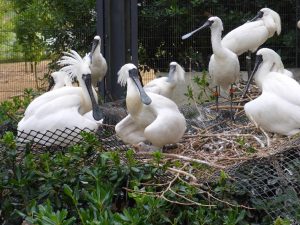Conservation of the black-faced spoonbill (Platalea minor)
Tama Zoological Park
Junko Ishii
The black-faced spoonbill (Platalea minor) is a bird that mainly inhabits East Asia; it breeds in parts of the Korean Peninsula, China, and Russia, and overwinters in the Korean Peninsula, Taiwan, China, and Japan. As its name implies, it has a black face with a spatula-shaped beak, and is a bird of the order Pelecaniformes, family Threskiornithidae. When it finds its prey in the water, it uses its spatula-shaped beak to sandwich fish and crustaceans, swallowing them whole for feeding. Its population once decreased to about 300 in the wild, but its population is recovering as a result of international conservation measures. A total of 3,941 individuals were confirmed in the International Black-faced Spoonbill Census 2018 (sponsored by the Hong Kong Bird Watching Society), which was conducted in collaboration with Asian researchers. However, the species still faces a critical situation due to factors such as migrating between areas where infectious diseases that are dangerous to birds (e.g., bird flu) are present.
In 1989, Tama Zoological Park borrowed two young female birds from Korea University and began to breed them. The zoo was later given a male individual and successfully bred them for the first time in 1996. The species was subsequently bred almost every year, and the zoo achieved successive breeding successfully. The zoo also accepts domestic and internationally protected individuals and has created a captive breeding program. Tama Zoological Park conducts planned breeding every year and currently has about 50 birds in captivity. The increased number of individuals are sent to domestic facilities, which then serve as breeding base facilities in Japan. However, it took several years for the brooding of the parent birds to maintain a stable breeding rate. The secret to the breeding program’s success was the combination of artificial and natural brooding.
In captivity, the black-faced spoonbill still nests, lays eggs, and incubates, but for some reason was unable to raise the hatched chicks. Freshly hatched chicks also had vocalizations when begging for food, and they also had a poor digestive capacity. Nevertheless, the parent birds tried to forcibly feed the newly hatched chicks, and fed them foreign objects such as sand, or were unable to feed the weakly vocalizing chicks, resulting in the death of the chicks. Therefore, the zookeepers decided to take care of the newly hatched chicks on behalf of the parent birds in order to assist in their brooding.
First, eggs just prior to hatching are collected from the nests of parent birds and exchanged with fake eggs. After the collected eggs are inspected, they are placed in an incubator that operates at a temperature of 37.2 °C and relative humidity of 55% in order to incubate the egg. This bird species involves the male and female frequently taking turns to incubate the egg, therefore, the egg is allowed to cool about three times a day, and periods when the eggs are not warmed are also set.
Brooding of the hatched chicks is conducted for approximately one week using a specialized brooding feed that is made from loach and powdered milk for animals. Once a chick that hatched at a weight of approximately 50 g exceeds 100 g in weight, its vocalizations become louder, it is able to properly beg for food from the parent bird, and develops an active digestive tract. Chicks that are raised in this way are exchanged with the fake eggs that were placed in the nest of the parent birds. Even if the egg suddenly transforms to a chick, the parent birds properly raise the chick by feathering and feeding the chick. This method maintains a stable growth rate. Of course, zookeepers can raise the chick with artificial brooding as well. However, individuals that grew up in a flock can grow more like a black-faced spoonbill as a member of the colony immediately after fledging (Photograph 1).
The biggest advantage of this method is that chicks can be raised even if there is no blood relationship between the chick to be entrusted and the parent bird. Chicks of pairs with valuable pedigrees but poor chick-rearing skills can be entrusted to pairs that are skilled at brooding chicks and have enough chicks left. Currently, there are two wild-protected individuals that are being kept in Tama Zoological Park. One individual has a broken wing and cannot fly, and the other individual has low visual acuity and has limited visibility. However, they formed a pair with captive breeding populations in Tama Zoological Park, from which we were able to obtain fertilized eggs. Individuals that cannot fly cannot succeed in raising their offspring due to limitations on their nesting sites and inability to create nests under favorable conditions. However, entrusting their eggs to pairs with high child-rearing skills enables them to leave behind their offspring. This method resulted in three out of four individuals protected domestically and internationally leaving behind their offspring. In the future, we will continue to accept actively any wild-protected individuals that cannot be released.
The captivity of the black-faced spoonbill began only 30 years ago. Many visitors learn about this bird for the first time in the zoo. We hope to disseminate information so that as many people can learn about this appealing bird and so that the data obtained through captivity could be utilized for wild individuals as well.

Fig.1 Brooding by black-faced spoonbills

